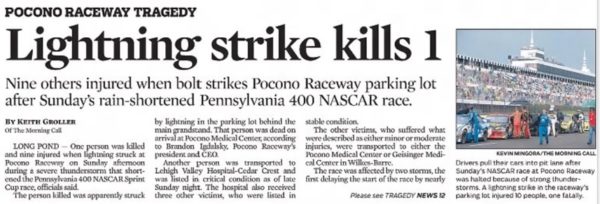A Preventable Weather Tragedy: From the Pages of Today in Weather History in 2012
On this date in 2012, the media carried stories about a preventable weather tragedy that occurred at the Pocono Speedway in Pennsylvania.
The Pocono Mountains of Pennsylvania are a summertime haven for millions of Northeasterners. The beautiful region is dotted with mountain resorts, lake and rivers.
On Sunday, August 5, 2012, thunderstorms were in the forecast for the area. A cold front was approaching the scenic area even as 85,000 race fans crowded into the Pococo Speedway near Long Pond, PA to watch the Pennsylvania 400.
The Storm Prediction Center had outlooked the area in a slight risk, their standard forecast for elevated chances of severe weather starting with the first convective outlook of the day. They continued that slight risk on all of the succeeding outlooks through the 20z update.
Torrential rains delayed the start of the race for two hours, but the green flag finally dropped at 2:58 p.m. Not ten minutes earlier, the SPC had issued a Mesoscale Discussion for developing storms across Central Pennsylvania, saying that a severe thunderstorm watch might be necessary. At 3:36 p.m. they did issue that watch. It included Monroe County, where the track is located.
The National Weather Service office that is responsible for Monroe County is Mount Holly, NJ, near Philadelphia. They issued a special weather statement at 3:58 p.m. saying that thunderstorms were approaching from the west. Lighting was specifically mentioned.
At 4:12 and 36 seconds, the forecaster in Mount Holly hit send on a severe thunderstorm warning for parts of five counties including Monroe and the track. The Speedway was not mentioned as a geographic point but it was clearly in the warning.
At 4:21, USA TODAY reported that the track made an announcement that severe storms were approaching At least one spectator reported hearing this annoucncement. the race track sent out a tweet at 4:30 saying that severe storms were in the area and would arrive within 10-15 minutes with high winds and lightning.
At 4:50, the NWS Mount Holly issued a severe weather statement that specifically mentioned the raceway and indicated an ETA of 5:05. At 4:54, the race was called after 98 of the scheduled 160 laps and Jeff Gordon was made the winner. An announcement was reportedly made as fans left the track, but rain and winds were already buffeting the area. As the winning team celebrated seven minutes later, a lightning bolt struck behind the grandstand followed by a sharp crack of thunder.
At 5:01 according to the Local Storm Report, one man was killed and other injured by that lightning bolt. A second lightning bolt on the grounds 90 minutes later sent more people to the hospital. A total of nine people were injured. The fatality was reportedly standing next to a car. The sad thing is that if had been in the car, he would have likely been just fine.
The victim bet that lightning wouldn’t hit him. He lost that bet.
Did the track properly notify its attendees? Did they have an effective severe weather plan in place? Did they provide proper shelter? Could they provide shelter effectively for 85,000 people? This was a severe thunderstorm. What if it had been a tornado? Is the onus on event management to have all the answers when severe weather comes calling? Where is the line between their responsibility and personal responsibility?
The NWS recommends that evacuation procedures begin when lightning is within 15 miles of a facility and the storm appears to be moving in. All activities should be suspended when lightning gets within 8 miles.
Some would chalk this up to being an act of God. I chalk it up to just another preventable human tragedy.
Category: ALL POSTS, Met 101/Weather History
















